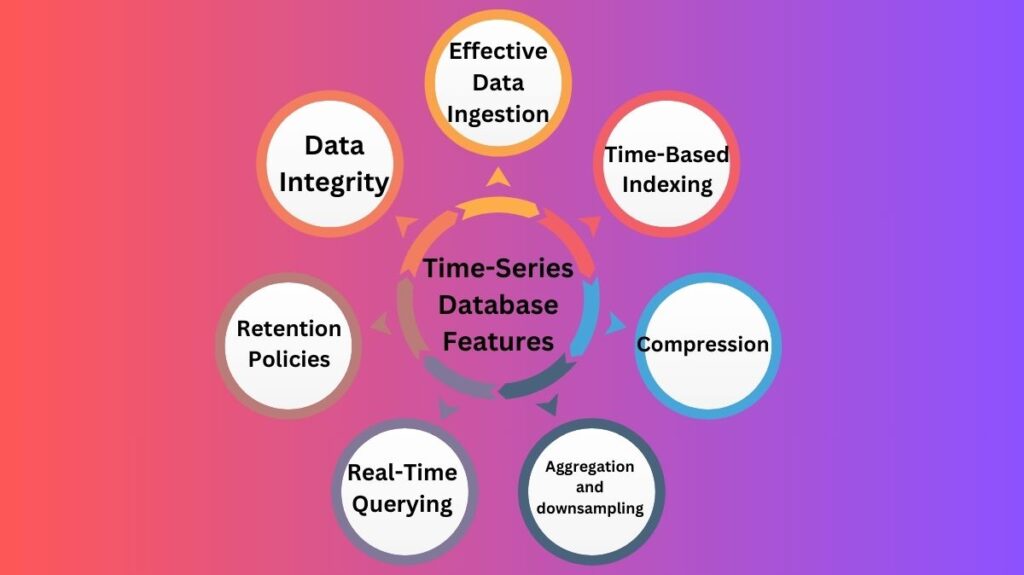Data Science Time-Series Database
In data science, time-series analysis is crucial for forecasting, trend analysis, anomaly identification, and optimization. Handling time-stamped data efficiently and effectively becomes crucial as more businesses create massive amounts. TSDBs store, retrieve, and analyze time-series data at scale. This article discusses time-series databases, their role in data science, and its features and tools.
What is Time-Series Data?
Time-series data is a time series of data points, usually at equal intervals. Finance (stock prices), IoT (sensor readings), healthcare (patient vitals), manufacturing (machine performance), and others use it. Time-series data is ordered and time-dependent.
Dealing with time-series data presents distinct issues.
- Modern data collecting methods create large amounts of time-stamped data every second. It’s difficult to store and query such enormous numbers.
- Trends, seasonality, and noise complicate time-series data interpretation and modelling.
- Immediately needed Financial and sensor monitoring applications require real-time analysis and decision-making.
- Disparities in Time-series data with missing values, irregular intervals, or outliers requires caution.
- Traditional relational databases (RDBMS) struggle to manage time-series data due to these issues. Here come Time-Series Databases (TSDBs).
What is Time-Series Database?
A time-series database handles time-series data well. These databases store and query time-stamped data efficiently, with high ingestion rates, rapid retrieval, and the ability to manage massive volumes of data over lengthy periods. Aggregation functions, downsampling, and windowing are their time-series analysis techniques.
Monitoring systems, IoT, and financial analytics use TSDBs since time is crucial to data structure.
Time-Series Database Features

Effective Data Ingestion: Due to the enormous velocity of time-series data (thousands of records per second), TSDBs must be able to efficiently ingest it.
Time-Based Indexing: TSDBs optimize queries on data points from a given time span. This functionality simplifies searching huge datasets by day, month, or year.
Compression:Due to the enormous volume of time-series data, TSDBs compress data to save space. Delta and run-length encoding are typically used to compress time-series data.
Aggregation and downsampling: High-frequency time-series data sets are common. Averages, sums, and medians over a time window can be calculated using TSDBs. This aggregation reduces analysis dataset size and speeds processing.
Real-Time Querying: Monitoring systems and real-time analytics use time-series databases because they can handle real-time queries.
Retention Policies:Data retention policies are necessary because time-series data grows quickly. Users can set data retention times in TSDBs. Storage can be optimized by automatically downsampling or deleting older data.
Data Integrity:Consistency and integrity of time-series data are essential for decision-making. Outliers, missing values, and data corruption are handled with TSDBs.
Most-used time-series databases
Each time-series database has its own features and meets distinct demands. Well-known TSDBs include:
InfluxDB:InfluxDB, a popular open-source TSDB, is optimized for time-series data. Time-series queries are handled by its SQL-like InfluxQL language. Real-time analytics, continuous queries, and efficient compression make InfluxDB a top time-series data management tool.
Prometheus:Another popular TSDB is Prometheus, especially in cloud-native systems. It’s used for monitoring and alerting in Kubernetes-based systems. Prometheus’ data gathering is efficient, and its query language, PromQL, is geared for time-series analysis.
TimescaleDB:TimescaleDB is a PostgreSQL plugin that converts relational databases to time-series databases. It provides relational database power with time-series workload scalability and performance by preserving the SQL interface.
Graphite:The mature time-series database Graphite is used for monitoring and visualizing data. The program is used for infrastructure monitoring and interfaces with others.
OpenTSDB: This open-source HBase-based TSDB scales horizontally. It handles huge time-series data effectively and is widely utilized.
OpenTSDB:For high-frequency trading and analysis, financial institutions employ KDB+, a columnar database specialized for time-series data. In-memory processing and its query language, q, provide low-latency performance.
Time-Series Database Uses
Many fields require time-series databases. Notable usage cases include:
Monitoring and Observability: Time-series data can track system health, discover anomalies, and trigger alarms in IT infrastructure and application performance monitoring. CPU, memory, and network traffic are monitored in real time for optimal system performance.
Internet of Things (IoT): Smart thermostats, wearables, and industrial sensors generate massive time-series data. Device performance, faults, and maintenance needs can be tracked and predicted using this data in a TSDB.
Financial Market Analysis:Stock prices, trade volumes, and market trends are tracked using time-series data in finance. Financial analysts and algorithmic traders use TSDBs for backtesting, predictive modeling, and real-time trading.
Healthcare: Time-series data includes blood pressure, heart rate, and other patient vitals collected regularly. TSDBs constantly monitor patient status, track previous trends, and predict health issues.
Energieverbrauch: Smart meters and sensors track energy usage, optimise resource distribution, and predict demand. This big, time-sensitive data is handled by TSDBs.
Supply Chain and Logistics:Tracking inventories, supply chain performance, and logistics operations need time-series data. Businesses may predict demand, enhance operations, and satisfy customers by studying data over time.
Benefits of Time-Series Databases
Improved Performance: For effective storage, retrieval, and analysis of time-series data, TSDBs are built.
Scalability: Horizontally scalable TSDBs make data volume expansion straightforward.
Real-Time Analytics: TSDBs allow real-time search and analysis of time-series data.
Cost-effective storage: TSDBs reduce massive dataset storage costs with efficient compression and data retention.
Conclusion
Time-series databases help modern data scientists manage, analyze, and query time-stamped data. Due to the rapid expansion of time-series data across industries, efficient storage and processing are critical for insights, projections, and operational choices. Organizations may maximize time-series data for real-time monitoring, predictive analytics, and trend analysis by using TSDBs. The increasing ecosystem of time-series databases provides solutions for every scale and requirement, substantiating their importance in data research.
